Microneedle-assisted delivery of verapamil hydrochloride and amlodipine besylate

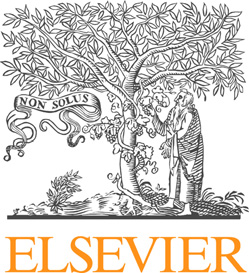

Contents lists available at
European Journal of Pharmaceutics and Biopharmaceutics
Microneedle-assisted delivery of verapamil hydrochlorideand amlodipine besylate
Monika Kaur Kevin B. Ita ,, Inna E. Popova , Sanjai J. Parikh , Daniel A. Bair
a College of Pharmacy, Touro University, Mare Island-Vallejo, CA, USAb Department of Land, Air and Water Resources, University of California, Davis, CA, USA
The aim of this project was to study the effect of stainless steel solid microneedles and microneedle roll-
Received 28 August 2013
ers on percutaneous penetration of verapamil hydrochloride and amlodipine besylate.
Accepted in revised form 14 October 2013
Available online 28 October 2013
yl-pentanenitrile is a calcium channel blocker agent that regulates high blood pressure by decreasingmyocardial contractilty, heart rate and impulse conduction. Amlodipine, (R, S)-2-[(2-aminoethoxy)
Transdermal drug delivery
calcium channel blocker that is used for the management of hypertension and ischemic heart disease.
Passive penetration of verapamil and amlodipine across the skin is low. In vitro studies were performed
with microneedle-treated porcine ear skin using vertical static Franz diffusion cells (PermeGear, Heller-
town, PA, USA). The receiver chamber contained 5 ml of PBS (pH7.4) and was constantly maintained at
Transcutaneous flux
37 °C temperature with a water circulation jacket. The diffusion area of the skin was 1.77 cm2. The donorcompartment was loaded with 1 ml of the solution containing 2.5 mg/ml of amlodipine besylate. Thedonor chamber was covered with parafilm to avoid evaporation. Passive diffusion across untreated por-cine skin served as control. Aliquots were taken every 2 h for 12 h and analyzed by liquid chromatogra-phy–mass spectrometry. Transcutaneous flux of verapamil increased significantly from 8.75 lg/cm2/h to49.96 lg/cm2/h across microneedle-roller treated porcine skin. Percutaneous flux of amlodipine besylatefollowing the use of stainless steel microneedles was 22.39 lg/cm2/h. Passive flux for the drug was1.57 lg/cm2/h. This enhancement of amlodipine flux was statistically significant. Transdermal flux ofamlodipine with microneedle roller was 1.05 lg/cm2/h in comparison with passive diffusion flux of0.19 lg/cm2/h. The difference in flux values was also statistically significant. Stainless steel solid micro-needles and microneedle rollers increased percutaneous penetration of verapamil hydrochloride andamlodipine besylate. It may be feasible to develop transdermal microneedle patches for these drugs.
Ó 2013 Elsevier B.V. All rights reserved.
hypertension is usually caused by another condition such as kidneydisease or tumors .
to the American Heart Association about 76.4 million
Several approaches have been used to manage hypertension.
people over age of 20 and older have high blood pressure in the
Angiotensin converting enzyme (ACE) inhibitors are used to lower
United States . According to the World Health organization, sub-
the vasoconstrictor angiotensin II. Angiotensin receptor blockers
optimal BP (>115 mmHg SBP) is responsible for 62% of cerebrovas-
act on AT1 and AT2 receptors to interrupt the action of angiotensin
cular disease and 49% of ischemic heart disease Environmental
II . Calcium channel blockers (CCBs) are antihypertensive agents
factors or genetics usually predispose individuals to hypertension.
used to mediate the transport of calcium in cardiac and vascular
High sodium intake, lack of exercise, stress levels or obesity can
cells. CCBs help relax blood vessels to reduce the workload of the
result in high blood pressure. Essential hypertension can go
undiagnosed as it does not have identifiable cause. Secondary
In this study, two antihypertensive drugs, verapamil and amlo-
dipine, were investigated for transdermal drug delivery. Verapamil,2-(3, 4-dimethooxyphenyl)-5-[2-(3,4 dimethoxyphenyl) ethyl-methyl-amino]-2-propan-2-yl-pentanenitrile, is a calcium channel
⇑ Corresponding author. College of Pharmacy, Touro University, 1310 Club Drive,
Mare Island-Vallejo, CA 94592, USA. Tel.: +1 7076385994; fax: +1 7076385266.
blocking agent. It is used in treatment of hypertension, angina pec-
E-mail address: (K.B. Ita).
toris and supraventricular arrhythmias . Increased calcium
1 Present address: Department of Plant, Soil and Entomological Sciences, University
channel blockers concentration in the plasma would result
of Idaho, Moscow, ID, USA.
0939-6411/$ - see front matter Ó 2013 Elsevier B.V. All rights reserved.
M. Kaur et al. / European Journal of Pharmaceutics and Biopharmaceutics 86 (2014) 284–291
improved cardiovascular condition. Transdermal delivery of verap-
and then drug loaded patch is applied for the penetration of the
amil will increase the concentration of the systemic verapamil that
drug across the skin. This mechanism is known as ‘poke and patch'.
would increase therapeutic efficacy. Amlodipine, (R, S)-2-[(2-
Solid microneedles create microchannels that can remain open for
period of 72 h under occlusive conditions . In vivo studies have
methoxycarbonyl-6-methyl-1, 4-dihydropyridine, is also a calcium
been conducted that showed that solid stainless steel microneedle
channel blocker that is used to treat hypertension and ischemic
application followed by insulin patch lowered blood glucose levels
Amlodipine partition coefficient in two different phases was re-
rollers (dermarollers) are stainless steel micronee-
ported in the literature. The two phases were n-octanol/water and
dle-embedded cylindrical surface that rolls over the skin to create
n-octanol/phosphate buffer saline. Log K values obtained were 2.96
micropores. Badran et al. studied the effect on microneedle length
and 3.09, respectively Verapamil partition coefficient (log P)
and chemical penetration enhancers on the transdermal penetra-
value obtained using octanol and water was 3.8 The permeabil-
tion of hydrophilic drug molecules across full thickness human
ity of these drugs across the skin is low. Several strategies have
skin. The hydrophilic substances investigated in the experiment
been used to overcome the excellent barrier properties of the stra-
were carboxyfluorescein and radiolabeled mannitrol. Micropores
tum corneum to enhance transdermal drug delivery. One approach
created by dermarollers were visualized using light microscopy
is the application of microneedles to increase percutaneous
and scanning electron microscopy (SEM). Skin treated with derma-
roller had higher transepidermal water loss values in comparison
Transdermal microneedles create micron sized pores in the skin
with intact skin .
to enhance delivery of the drug across the skin. Micron sized nee-
aim of the present study was to investigate microneedle-
dles are ideal for patient adherence as they do not stimulate nerves
mediated transdermal delivery of antihypertensive agents – verap-
that are associated with pain. Microneedles improve patient com-
amil hydrochloride and amlodipine besylate across pig skin.
pliance as patient with needle phobia will be more likely to apply
Stainless steel microneedles and microneedle rollers were used
the patch because of its painlessness. Additionally, patients can
in our investigation to determine transcutaneous fluxes of
administer the drug by themselves . Microneedle-mediated
verapamil and amlodipine across pig skin. This paper focuses on
drug delivery only disrupts the stratum corneum and epidermis
microneedle-assisted transdermal delivery of verapamil hydro-
but it does not reach nerve fibers and blood vessels in the dermis
chloride and amlodipine besylate through porcine ear skin.
Patients with gastrointestinal tract irritation are more likelyto benefit from the use of microneedle mediated patches as the
2. Materials and methods
drug gets directly into systemic circulation. Furthermore, drugswith poor absorption rate and instability are ideal for transdermal
2.1. Chemicals and reagents
drug delivery Transdermal drug delivery is beneficial to pa-tients with chronic conditions such as diabetes. Furthermore, it is
buffered saline (PBS), verapamil hydrochloride and
useful for patients that have poor adherence as they are taking
amlodipine besylate were purchased from Sigma Aldrich Co. (St.
multiple medications or going through illness where they simply
Louis, MO, USA). Porcine ears were obtained from Animal Technol-
forget to take the medication at the right time such as those suffer-
ogies (Tyler, TX, USA). Double distilled ionized water was prepared
ing from Alzheimer's disease. Microneedle-mediated transdermal
using NanoPure Infinity Ultrapure water purification system.
drug delivery reduces skin irritation
Factors that affect the diffusion rate across the skin are micro-
2.2. Stainless steel microneedles
needle density, microneedle length, number of applications anddrug concentrations. According to Gomaa et al., increase in the
stainless steel microneedle arrays (manufactured
microneedle density led to increase in the level of drug penetration
by NanoBioSciences LLC, Sunnyvale, CA) were supplied by Stanford
across the skin The studies also demonstrated that applica-
University Biomaterials and Advanced Drug Delivery Laboratory.
tion of longer microneedles increased the drug diffusion through
These were used to create microchannels in porcine skin for trans-
skin. Multiple applications of the microneedles and higher concen-
dermal drug delivery. Microneedle rollers were purchased from
tration of the drug solution in the donor chamber of the Franz ver-
New Skin Care Collection, Tallahassee, Florida, USA.
tical cells led to an increase in transdermal drug delivery.
Hollow microneedles are designed with channels that deliver
medications and extract biological fluids . Controlled drug diffu-
2.3. Skin preparation
sion is achievable with hollow microneedles where drug deliveryrate can range from fast to slow diffusion and it can be used for
Animal Care and Use Committee (IACUC), Touro
time-dependent delivery across the skin. Hollow microneedles
University, Mare Island-Vallejo, CA approved the experiments.
can be fabricated from glass, polymer and metal. Insulin delivery
Pig ears were obtained from Animal Technologies (Tyler, Texas,
through hollow microneedles was shown to reduce the blood glu-
USA). Skin pieces were thawed at room temperature and cleaned
cose levels in type 1 diabetic patients . During hollow micronee-
with tap water. An electric clipper was used to trim pig ear hairs.
dle application, upper layer of the skin is disrupted and the drug is
An electric dermatome (Robbin's Instruments, Chatham, NJ, USA)
released into the skin. This is known as ‘poke and flow' . These
was used to section the skin to a thickness of 550 lm. Porcine ears
microneedles are used to deliver liquid drugs across the skin as it is
were then stored at a temperature of
20 °C for no longer than two
facilitated by pressure-driven flow
months before use.
Solid microneedles are applied to skin with pressure that cre-
ates micron sized holes in the skin for penetration of the drug
2.4. Diffusion studies
across the skin Silicon, polymers, metal and ceramic are exam-ples solid microneedles. Metals such as stainless steel have been
vitro permeation experiments were conducted using vertical
used to create needles (i.e. hypodermic needles) for decades .
Franz diffusion cells. Microneedle-treated porcine skin, derma-
Furthermore, stainless steel microneedles provide good mechani-
tomed to 550 lm was mounted on the donor chambers of three
cal strength and are easy to cut with laser beam . Microchan-
cells having an area of 1.77 cm2. Three cells with untreated pig skin
nels are created after insertion and removal of the microneedles,
served as controls. The volume of the diffusion cells was 12 ml. The
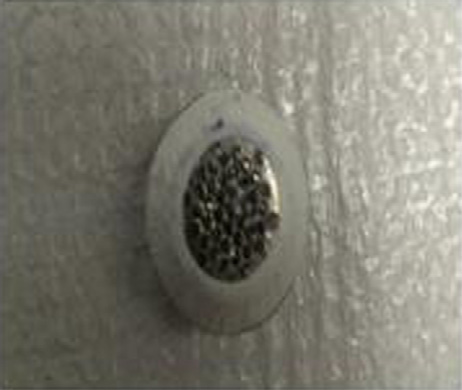
M. Kaur et al. / European Journal of Pharmaceutics and Biopharmaceutics 86 (2014) 284–291
upper donor chamber and lower receiver chamber of the Franz ver-
verapamil hydrochloride and amlodipine besylate. The micronee-
tical cell were fastened together by means of a clamp, along with
dles had a density 187 needles/cm2 and each microneedle was
skin between the two chambers. 2 ml of verapamil solution
500 lm long.
(50 mg/ml) or amlodipine besylate (2.5 mg/ml) was loaded onto
DermaRoller is a device that contains microneedles mounted on
donor chambers and covered with Parafilm. Aliquots of the recep-
cylindrical surface that rolls over the skin. There were 540 micro-
tor solution were collected at the interval of 2 h for a 12 h period.
needles mounted on cylindrical drum that were 500 lm in length.
The samples were stored at 4 °C until analysis by liquid chroma-
The images () were collected using HTC one-X camera.
tography–mass spectrometry (LC–MS). Receptor chambers were
Scanning electron microscopy was used to visualize the stain-
replenished by an equal volume of fresh phosphate buffer solution.
less steel microneedles and microconduits. The top view shows
All of the six receptor chambers contained a magnetic stirrer to
that microneedles were aligned symmetrically. The image from
maintain constant concentration.
the side view shows that needles are sharp-tipped. SEM image ofsingle microneedle determines the length and width of the micro-
2.5. LC–MS analysis
Microconduits created across pig skin by microneedles deter-
S/MS analysis was performed using an Agilent
mine the disruption of the stratum corneum, which acts as an
series 1200 HPLC with diode-array and Agilent 6320 Ion Trap mass
excellent barrier to transdermal penetration. It also shows that
spectrometer detector (Agilent Technologies, Palo Alto, CA). Chro-
microneedles successfully penetrated the skin to create microp-
matographic separation was carried out on the reverse-phase Agi-
ores. demonstrates that microchannels are symmetrical
lent Zorbax Eclipse Plus C18 (100 � 2.1 mm, 3.5 lm) analytical
across porcine skin. Single microconduit has diameter of 100 lm
column, which was protected by a guard column with the same
that allows diffusion of small hydrophilic molecules ).
stationary phase (12.5 � 4.6 mm, 5 lm) (Agilent Technologies, PaloAlto, CA). Column temperature was set at 40 °C, and autosamplertemperature was set at 4 °C. The mobile phase consisted of 0.1%
In vitro permeation studies
formic acid in water (solvent A), and 0.1% formic acid in methanol(solvent B). The gradient was performed at 0.4 ml/min with an ini-
In vitro permeation experiments were conducted to study the
tial condition of 10% of mobile phase B for 2 min. Mobile phase B
transdermal delivery of two antihypertensive agents – verapamil
was increased to 90% at 3 min and held at 90% B to 8 min. Calibra-
hydrochloride and amlodipine besylate. The experiments were
tion curve standards were freshly prepared in PBS buffer solution.
performed on porcine skin using stainless steel microneedles.
The MS data were collected in the positive ESI MS/MS mode. Neb-
Porcine skin was used to investigate transdermal drug delivery be-
ulizer temperature was 350 °C, nebulizer pressure was 50 psi, and
cause it is a good model of human skin. Pig ear skin was mounted
the drying gas flow rate was 10.0 l/min. Compounds were quanti-
between donor and receiver compartment, where the drug was
fied in positive ESI MS/MS mode by quantifying specific parent ion.
loaded into the donor chamber and aliquots were collected from
UV spectra were collected for each compound.
receiver chamber. Liquid chromatography–mass spectrometry(LC–MS) was used to determine the concentration of the drug in
2.6. Characterization of the microneedles and microconduits – SEM
the samples. Cumulative amount versus time graphs for passivediffusion and microneedle-mediated diffusion were plotted
electron microscopy (SEM) was performed at the Elec-
tron Microscopy Laboratory, Department of Medical Pathology andLaboratory Medicine, School of Medicine, University of California atDavis. SEM was used to visualize stainless steel microneedles and
Transdermal drug flux
the microchannels created in porcine skin. The device wasmounted onto an aluminum stub using DUCO cement mix with
Flux values were determined using steady-state portion of the
carbon shavings (for conductivity), sputter coated with gold using
cumulative amount versus time curves . Percutaneous pen-
a PELCO SC-7 coater and viewed on the FEI XL 30 scanning electron
etration of the drug across non-treated pig skin (controlled skin)
microscope. Skin was fixed with Karnovsky's fixative in 0.1 M so-
was low. Passive transdermal drug flux for verapamil hydrochlo-
dium phosphate buffer then washed with 0.1 M sodium phosphate.
ride and amlodipine besylate were 8.75 lg/cm2/h and 1.57 lg/
Dehydration was accomplished in increasing concentrations of
cm2/h respectively. In our study, transdermal flux of verapamil
ethanol through 100% ethanol and critical point dried in a Tousimis
after DermaRoller application was 49.96 lg/cm2/h () while
931.GL Autosamdri critical point dryer. The mites were mounted
transcutaneous flux of amlodipine besylate following solid micro-
on aluminum stubs and sputter coated with gold using a PELCO
needle application was 22.39 lg/cm2/h (Drug flux value
SC-7 coater. The samples were viewed on an FEI XL30 TMP SEM.
for amlodipine besylate following passive diffusion was 0.19 lg/cm2/h when compared to flux value obtained (1.05 lg/cm2/h) fol-
2.7. Statistical analysis
lowing twelve passes of stainless steel microneedle roller (
software was used for statistical analysis. Mann–
Whitney rank sum test was used to determine the statistical signif-icance of data obtained from the experiments. Mean of replicatemeasurements (n = 3) with corresponding standard errors (SE)was used to plot the graphs.
3.1. Characterization of microneedles and microconduits
Fig. 1a. Stainless steel microneedles, density 187 microneedles/cm2 and 500 lm in
steel microneedles were applied onto porcine skin to
length. (For interpretation of the references to color in this figure legend, the reader
study percutaneous penetration of antihypertensive drugs –
is referred to the web version of this article.)
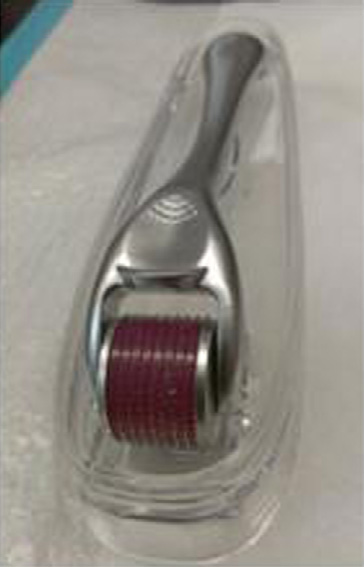
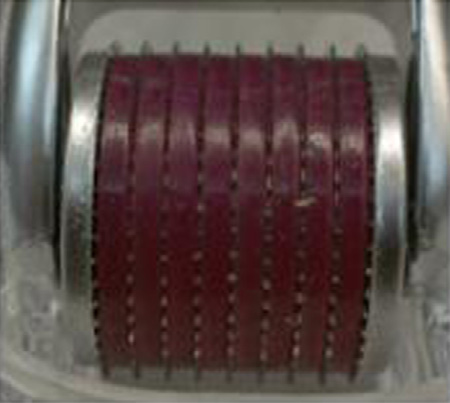
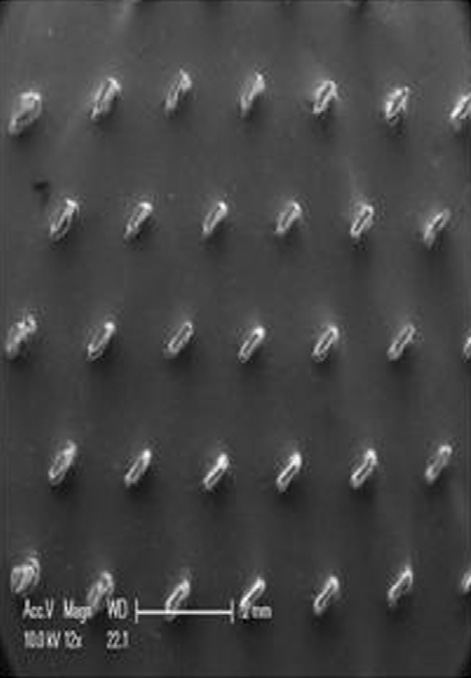
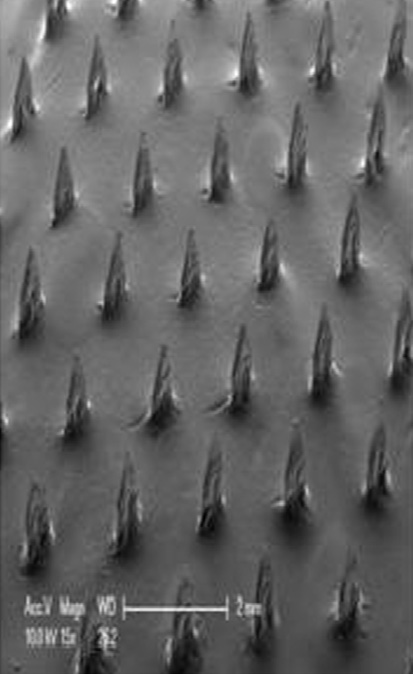
M. Kaur et al. / European Journal of Pharmaceutics and Biopharmaceutics 86 (2014) 284–291
Fig. 1b. DermaRoller, total-540 microneedles. (For interpretation of the referencesto color in this figure legend, the reader is referred to the web version of thisarticle.)
Fig. 2b. Displays side view of microneedles.
Fig. 1c. Closer view of cylindrical drum of DermaRoller. (For interpretation of thereferences to color in this figure legend, the reader is referred to the web version ofthis article.)
Fig. 2c. Visualized single microneedles.
Fig. 2a. Shows top view of stainless steel microneedles using SEM.
Fig. 3a. Shows microchannels created by using scanning electron microscopy.
Our results indicate that enhanced permeation of verapamil
hydrochloride was statistically significant after the application of
dose of the drug is administered at once. With transdermal patches,
microneedle roller. For amlodipine besylate, there was also statisti-
there is gradual release of the active ingredient.
cally significant enhancement in transdermal fluxes when solid and
medications are administered transdermally, the drug
microneedle rollers were used. Stainless steel solid microneedles
passes through the stratum corneum, epidermis and dermis. The
and microneedle rollers were successfully used to breach the epider-
stratum corneum which is the thin (15–20 lm) and outermost
mis creating microchannels that allowed percutaneous penetration
layer of the epidermis poses a major obstacle for transdermal
across pig ear skin. Transcutaneous drug delivery is beneficial for pa-
absorption. This layer is made up of corneocytes filled with keratin
tients who face limitations posed by oral or parental drug adminis-
embedded in a lipid matrix. The lipid matrix consists of ceramides,
tration such as first-pass metabolism, gastric irritation and erratic
cholesterol and free fatty acids. Dermis is the innermost layer that
absorption . Furthermore, transdermal drug delivery is more
contains nerves, blood vessels, lymph vessels, hair follicles, seba-
advantageous in comparison with bolus delivery method, where full
ceous glands and sweat glands Meyer et al. showed that
M. Kaur et al. / European Journal of Pharmaceutics and Biopharmaceutics 86 (2014) 284–291
Fig. 6. Shows passive and microneedle-assited transdermal permeation of amlo-
Fig. 3b. Visualize the presence of single microscope using scanning electron
dipine besylate after microneedle roller application across pig ear skin (500 lm
length, 540 density). (For interpretation of the references to color in this figurelegend, the reader is referred to the web version of this article.)
Fig. 7a. Displays drug flux of verapamil through passive (non-treated skin,controlled) diffusion and microneedle roller treated pig skin (p-value < 0.05). (For
Fig. 4. Shows passive diffusion and microneedle-mediated diffusion of verapamil
interpretation of the references to color in this figure legend, the reader is referred
with microneedle roller across pig skin. (For interpretation of the references to color
to the web version of this article.)
in this figure legend, the reader is referred to the web version of this article.)
Fig. 7b. Displays transdermal flux of amlodipine desylate through passive (non-treated skin, controlled) and microneedle-treated skin after application of solid
Fig. 5. Displays transdermal penetration of amlodipine across non-treated skin and
microneedles (stainless steel solid microneedles, 500 lm length, and density of
microneedle-treated skin after solid microneedle was applied (stainless steel solid
187 microneedle/cm2) (p-value < 0.05). (For interpretation of the references to color
microneedle, 500 lm length, and density of 187 microneedle/cm2). (For interpre-
in this figure legend, the reader is referred to the web version of this article.)
tation of the references to color in this figure legend, the reader is referred to theweb version of this article.)
porcine ear skin has structural characteristics similar to human
ducted. Elmahjoubi et al. demonstrated a successful disruption of
skin. Light microscopy, transmission electron microscopy and cryo
the stratum corneum by measuring transepidermal water loss
scanning electron microscopy methods were used to observe stra-
using Aquaflux probe. Transepidermal water loss (TEWL) measures
tum superficiale dermidis of pig ear skin. The results reported by
the water vapor flux crossing the skin into external environment
the authors show that pig skin can be used as a model for human
integument. In addition, they also reported the storage conditions
Different strategies have been used to increase transdermal per-
for pig skin at temperature 4 °C . Our pig skin samples were
meation of the molecules such as iontophoresis, sonophoresis and
kept at the same temperature before permeation studies were con-
chemical penetration enhancers. Iontophoresis uses mild electric
M. Kaur et al. / European Journal of Pharmaceutics and Biopharmaceutics 86 (2014) 284–291
variables were increased-number of microneedle arrays, micronee-dle length and drug concentration in the donor chamber .
our experiment, stainless steel dermarollers and micronee-
dles were utilized to study the transcutaneous penetration ofverapamil hydrochloride and amlodipine besylate. Digital imagesof stainless steel microneedles and dermarollers are shown inOur results demonstrated increased transdermal drugdelivery of verapamil hydrochloride and amlodipine besylate inin vitro percutaneous experiments. In addition, scanning electronmicroscopy was used to visualize microneedles. Li et al. usedSEM technique to characterize maltose microneedles and metaldermarollers. The authors also investigated transcutaneous perme-ation of human Immunoglobulin G across hairless rat skin Park et al. demonstrated improvement in the transdermal absorp-
Fig. 7c. Shows transdermal flux of amlodipine besylate across porcine skin using
tion of acetylsalicylic acid across human and porcine cadaver skin
microneedle rollers (p-value < 0.05). (For interpretation of the references to color in
using microneedle roller. Microneedle rollers create multiple inser-
this figure legend, the reader is referred to the web version of this article.)
tions as the roller rotates across the skin . Zhou et al. showedenhancement in the penetration of insulin on microneedle-roller
current to deliver charged molecules across the skin. Ita and Banga
treated rat skin. The results obtained showed that longer length
showed increased transcutaneous absorption of penbutolol sulfate
microneedle rollers led to increased reduction of blood glucose le-
across porcine using iontophoresis. Anodal iontophoresis was used
vel in comparison with shorter microneedle. The characterization
to demonstrate enhancement in transdermal delivery of penbuto-
of the microchannels was performed using Evan's blue staining
lol sulfate because the molecule is positively charged Yamam-
oto et al. studied in vitro and in vivo permeation of naloxone by
our investigation, microconduits were visualized using scan-
anodal iontophoresis. Anodal iontophoresis involves transfer of
ning electron microscope. The presence of micropores was showed
positively charged molecule across the epidermal barrier by using
that microneedles penetrated the stratum corneum. Kumar et al.
electrorepulsion. The investigators reported enhancement of
conducted experiments to test transdermal delivery of calcein
in vitro transdermal diffusion of naloxone across pig and rat skin
and human growth hormone across porcine skin using maltose
using iontophoresis, which was proportional to current intensity.
microneedles. The presence of microchannels was shown by meth-
In addition, in vivo Iontophoretic patches were able to delivery nal-
ylene blue staining. In addition, they also determined the unifor-
oxone across dorsal skin of a rat . Even though iontophoresis
mity among the micropores through calcein imaging Banga
allows increase in transdermal penetration of small and hydro-
et al. showed that microchannels created in the skin after the
philic molecules, it can only deliver molecules smaller than
application of the microneedles are large enough to allow the pen-
13 kDa . Wang et al. also discussed about skin irritation caused
etration of wide range of molecules as they are in nanometer
by iontophoresis at higher electric voltage .
dimensions. Disruption of the stratum corneum after microneedle
Another most commonly used technique used to investigate
application was confirmed by histological sectioning of skin sam-ples .
transdermal permeation studies is the use of chemical penetration
hydrochloride and amlodipine besylate have low
enhancers . Chemical enhancers are substances that are used
penetration rates across the skin. Xie et al. conducted experiments
to increase the permeability of the skin. Puglia et al. demonstrated
that showed transdermal delivery of calcein and bovine serum
effects of polyunsaturated fatty acids (PUFA) and chemical enhanc-ers on permeation of atenolol across human skin The results of
albumin, which have small molecular structure and hydrophilic
the experiment showed increase in atenolol permeation flux with
nature, respectively. Franz diffusion cells were used to study calce-
PUFA and transcutol penetration enhancers. Two polyunsaturated
in and BSA diffusion across rat skin using coated microneedles
fatty acids tested in their experiments were eicosapentaenoic acid
Park et al. also showed transdermal delivery of calcein, bovine ser-
(EPA) and docosahexaenoic acid (DHA), which increased transder-
um albumin and macromolecular proteins using biodegradable
mal absorption of atenolol. Lee et al. also investigated the transcu-
microneedles (also known as polymeric microneedles) across hu-
taneous absorption of lidocaine across pig skin and human skin
man cadaver skin. Successful percutaneous penetration of calcein
after chemical penetration enhancers were applied. Application of
and human growth hormone across pig skin have been reported
N-methyl pyrrolidone (NMP) and isopropyl myristate (IPM)
where calcein represents a small molecular weight molecule and
showed significant increase in transdermal absorption of lidocaine,
hGH acts as a larger molecule of 22 kDa .
which improved permeation profile by increasing drug solubility
channel blockers are antihypertensive agents used to
and partitioning into the skin. Although chemical penetration
manage high blood pressure. To maintain normal blood pressure,
enhancers improve percutaneous absorption of the molecules,
L-type voltage gated calcium channels play an important role as
many of them cause skin irritations at higher concentrations .
they regulate constriction of the vascular smooth muscle and car-
Our experiment involved the use of microneedles to investigate
diac muscle. Verapamil and amlodipine are L-type calcium channel
the transport of antihypertensive agents across porcine skin. Sev-
blockers that belong to distinct chemical classes, phenylalkylam-
eral variables effect the percutaneous penetration of the molecule
ines and dyhydropyridines, respectively Verapamil has low
across the skin such as microneedle length, microneedle density,
bioavailability where only 10–20% of the verapamil dose get
and insertion force and insertion time. In addition, microneedle fab-
absorbed from the digestive tract into circulatory system in
rication material and design also impacts transcutaneous delivery
unchanged form On the other hand, amlodipine has a
of the molecules. In most studies, it has been proven that increased
bioavailability of 65%, longer half-life and it takes longer for the
microneedle length and microneedle density enhance permeation
concentration to reach maximum because of high tissue affinity
of the molecules across epidermis. Li et al. studied transdermal
Even though amlodipine has benefits if taken orally, it still
delivery of antibodies using maltose microneedles. It was proven
poses limitations to patients due to gastric irritation, erratic
that human IgG delivery was increased when the following
absorption and an initial high plasma concentration.
M. Kaur et al. / European Journal of Pharmaceutics and Biopharmaceutics 86 (2014) 284–291
hypertensive patients have poor adherence to existing
Adamson and Pat Kysar of the Electron Microscopy Laboratory,
medications. Most of the tablets are taken in the oral form that
Department of Medical Pathology and Laboratory Medicine, School
passes through liver to get metabolized, known as first pass metab-
of Medicine, University of California at Davis for technical assis-
olism effect. In addition, oral medications have higher risk of ad-
tance and Touro University, California for financial support.
verse effects due to variable absorption profile. Patients onchronic conditions are required to take medication on daily basisto manage their condition. Most of them are on therapy that re-
quires taking medication twice or three times a day. Sometimes,patients miss doses of their medications due to amnesia. This can
be resolved with transdermal patches. Furthermore, patients' com-
pliance decreases with parental route of drug administration be-
cause of needle phobia or needle pain usually caused by
conventional hypodermic needles. Li et al. reported that pain in-
duced by microneedles of length 500–1500 lm is relatively low
compared to hypodermic needles .
of transdermal delivery include stable plasma con-
centrations. Administration of the drugs through transdermal
patches is free of pain, avoids the risk of transmission of blood
borne pathogen and allows patient compliance due to ease of
use, especially for elder patients. Microneedle-mediated transder-
mal drug delivery reduces the chance of infections and skin irrita-
tions Gomaa et al. studied transcutaneous penetration of low
molecular weight heparin nadroparin calcium using dissolvable
microneedles. Since LMWH are large molecules, hydrophilic and
have low bioavailability, they are administered parentally. Parental
route of drug administration is associated with pain, and safety is-
sues. According to National patient safety agency, 2716 incidents
were reported related to safety concerns. Transdermal drug deliv-
ery has proven to be better alternative for administration of LMWH
as successful percutaneous delivery was reported by the authors
results of our study show that the increase in transdermal
flux of verapamil hydrochloride across porcine skin following the
application of microneedle roller was statistically significant
(p < 0.05). Amlodipine besylate flux also increased significantly
after application of solid microneedles and microneedle rollers
(p < 0.05). Further in vitro studies will be conducted to test other
variables that effect transdermal dug flux such as microneedle de-
sign, length, density, and drug concentrations. In addition, different
techniques such as iontophoresis, sonophoresis and chemical
enhancers can be combined with microporation to study the effect
on percutaneous penetration of these antihypertensive agents. Fu-
ture studies would also involve in vivo studies to investigate the
efficiency of transdermal drug delivery systems for verapamil
hydrochloride and amlodipine besylate.
iated transdermal drug delivery is beneficial
for patients with chronic conditions such as hypertension, diabetes
and Alzheimer's disease. Transdermal patches are convenient for
patients as it allows for self-administration and it is a pain-free
process that produces no biohazardous waste. Due to these advan-
tages, it has the capability to improve patient's adherence to phar-
macotherapy. The results of this study show that application of
stainless steel microneedles increased transdermal delivery of
verapamil hydrochloride and amlodipine besylate across porcine
ear skin. These results show that transdermal patches can be devel-
oped for these antihypertensive drugs.
The authors are grateful to Dr. Jayakumar Rajadas of Stanford
University Biomaterials and Advanced Delivery Laboratory for the
supply of Adminpatch stainless steel microneedle arrays; Grete
M. Kaur et al. / European Journal of Pharmaceutics and Biopharmaceutics 86 (2014) 284–291
Source: http://www.adminmed.com/files/web/publications/2014_MN-assisted_delivery_of_verapamil_hydrochloride_and_amlodipine_besylate-Ita.pdf
Ley del Régimen Penitenciario DECRETO NÚMERO 33-2006 EL CONGRESO DE LA REPÚBLICA DE GUATEMALA Que es deber del Estado de Guatemala, garantizar a los habitantes de la República la vida, la libertad, la justicia, la seguridad, la paz y el desarrollo integral de la persona. Que son fines del Sistema Penitenciario la readaptación social y reeducación de las personas reclusas; así como cumplir con las normas mínimas para la custodia y tratamiento de las mismas.
Stephan Wissner • Vordiplom NT2 • SS2005 Köln International School of Design Betreut durch Stefan Terlinden Lehrgebiet Audiovisuelle Medien „Helden aus Knete" Über die Filme & Erfolge des britischen Filmstudios Aar 4 Vorwort 6 Die Geschichte des Knetgummi-Stop-Trick-Films Von „Voyage dans le Lune" bis zu „die Tintenfische aus dem zweiten Stock"









